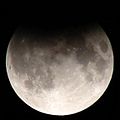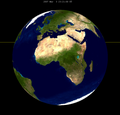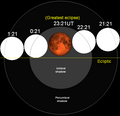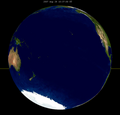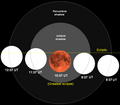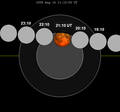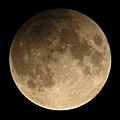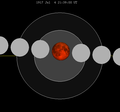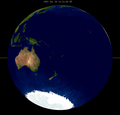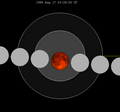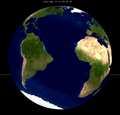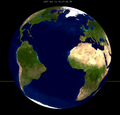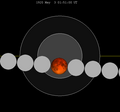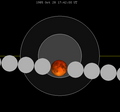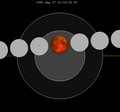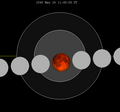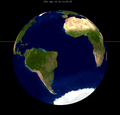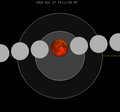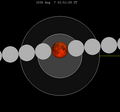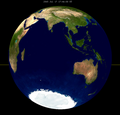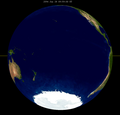Top Qs
Timeline
Chat
Perspective
August 2007 lunar eclipse
Central lunar eclipse From Wikipedia, the free encyclopedia
Remove ads
A total lunar eclipse occurred at the Moon’s ascending node of orbit on Tuesday, August 28, 2007,[1] with an umbral magnitude of 1.4777. It was a central lunar eclipse, in which part of the Moon passed through the center of the Earth's shadow. A lunar eclipse occurs when the Moon moves into the Earth's shadow, causing the Moon to be darkened. A total lunar eclipse occurs when the Moon's near side entirely passes into the Earth's umbral shadow. Unlike a solar eclipse, which can only be viewed from a relatively small area of the world, a lunar eclipse may be viewed from anywhere on the night side of Earth. A total lunar eclipse can last up to nearly two hours, while a total solar eclipse lasts only a few minutes at any given place, because the Moon's shadow is smaller. Occurring about 2.4 days before perigee (on August 30, 2007, at 20:10 UTC), the Moon's apparent diameter was larger.[2]
This was the most recent central lunar eclipse of Saros series 128 as well as the "longest and deepest lunar eclipse to be seen in 7 years". In the total lunar eclipse of July 16, 2000 the moon passed within two arc minutes of the center of the Earth's shadow. In comparison, this still very deep eclipse was off-center by over 12 minutes of arc.[3] The next total lunar eclipse of a longer duration was on June 15, 2011.
Remove ads
Visibility
Summarize
Perspective
Viewing from Oceania was favored for the eclipse, because at the moment of greatest eclipse (10:37:22 UTC), the Moon was at the zenith of French Polynesia. The Pacific regions of Canada and the continental United States (including all of Alaska) witnessed the whole event, along with most of eastern Australia, New Zealand and all the Pacific Island regions (except New Guinea), and the tip of the Chukchi Peninsula that includes the town of Uelen, Russia. The majority of the Americas observed an abbreviated eclipse, with moonset occurring at some time during the eclipse. Siberia, far eastern Russia, eastern South Asia, China, the rest of eastern and southeastern Asia, New Guinea, and the rest of Australia missed out on the beginning of the eclipse, because the eclipse occurred at or close to moonrise in those regions.[4]
Luzon (except Visayas and Mindanao) in the Philippines, particularly Metro Manila, missed the rare eclipse entirely, due to clouds in the area due to the rainy season, which saddened many eclipse watchers in the area, but the eclipse was sighted by other amateur astronomers in other parts of the country as the lunar eclipse seen in clear skies. The eclipse was also missed in New Guinea, especially Port Moresby because of clouds. Greenland, Europe (including western Russia), Africa, western Asia, western Central Asia, and western South Asia missed the eclipse completely.[5]
 |
 Hourly motion shown right to left |
 The Moon's hourly motion across the Earth's shadow in the constellation of Aquarius. |
 Visibility map | ||
Remove ads
Images

Gallery
 From the Oregon Coast. |
 From Swifts Creek, Australia. (3 minute intervals) |
 From Bakersfield, California. |
- From Nagayo, Nagasaki, 10:33 UTC.
- A wider angle shows stars around the moon.
- A full sky view (moon on left) shows the Milky Way (across the center), which is usually invisible under a full moon.
- From Melbourne, Australia.
Eclipse details
Shown below is a table displaying details about this particular lunar eclipse. It describes various parameters pertaining to this eclipse.[6]
Remove ads
Eclipse season
This eclipse is part of an eclipse season, a period, roughly every six months, when eclipses occur. Only two (or occasionally three) eclipse seasons occur each year, and each season lasts about 35 days and repeats just short of six months (173 days) later; thus two full eclipse seasons always occur each year. Either two or three eclipses happen each eclipse season. In the sequence below, each eclipse is separated by a fortnight.
Remove ads
Related eclipses
Summarize
Perspective
Eclipses in 2007
- A total lunar eclipse on March 3.
- A partial solar eclipse on March 19.
- A total lunar eclipse on August 28.
- A partial solar eclipse on September 11.
Metonic
- Preceded by: Lunar eclipse of November 9, 2003
- Followed by: Lunar eclipse of June 15, 2011
Tzolkinex
- Preceded by: Lunar eclipse of July 16, 2000
- Followed by: Lunar eclipse of October 8, 2014
Half-Saros
- Preceded by: Solar eclipse of August 22, 1998
- Followed by: Solar eclipse of September 1, 2016
Tritos
- Preceded by: Lunar eclipse of September 27, 1996
- Followed by: Lunar eclipse of July 27, 2018
Lunar Saros 128
- Preceded by: Lunar eclipse of August 17, 1989
- Followed by: Lunar eclipse of September 7, 2025
Inex
- Preceded by: Lunar eclipse of September 16, 1978
- Followed by: Lunar eclipse of August 7, 2036
Triad
- Preceded by: Lunar eclipse of October 27, 1920
- Followed by: Lunar eclipse of June 28, 2094
Lunar eclipses of 2006–2009
This eclipse is a member of a semester series. An eclipse in a semester series of lunar eclipses repeats approximately every 177 days and 4 hours (a semester) at alternating nodes of the Moon's orbit.[7]
The lunar eclipses on July 7, 2009 (penumbral) and December 31, 2009 (partial) occur in the next lunar year eclipse set.
Metonic series
The Metonic cycle repeats nearly exactly every 19 years and represents a Saros cycle plus one lunar year. Because it occurs on the same calendar date, the Earth's shadow will be in nearly the same location relative to the background stars.
|
|
 |
 |
Saros 128
This eclipse is a part of Saros series 128, repeating every 18 years, 11 days, and containing 71 events. The series started with a penumbral lunar eclipse on June 18, 1304. It contains partial eclipses from September 2, 1430 through May 11, 1827; total eclipses from May 21, 1845 through October 21, 2097; and a second set of partial eclipses from November 2, 2115 through May 17, 2440. The series ends at member 71 as a penumbral eclipse on August 2, 2566.
The longest duration of totality was produced by member 37 at 100 minutes, 43 seconds on July 26, 1953. All eclipses in this series occur at the Moon’s ascending node of orbit.[8]
Eclipses are tabulated in three columns; every third eclipse in the same column is one exeligmos apart, so they all cast shadows over approximately the same parts of the Earth.
Tritos series
This eclipse is a part of a tritos cycle, repeating at alternating nodes every 135 synodic months (≈ 3986.63 days, or 11 years minus 1 month). Their appearance and longitude are irregular due to a lack of synchronization with the anomalistic month (period of perigee), but groupings of 3 tritos cycles (≈ 33 years minus 3 months) come close (≈ 434.044 anomalistic months), so eclipses are similar in these groupings.
Inex series
This eclipse is a part of the long period inex cycle, repeating at alternating nodes, every 358 synodic months (≈ 10,571.95 days, or 29 years minus 20 days). Their appearance and longitude are irregular due to a lack of synchronization with the anomalistic month (period of perigee). However, groupings of 3 inex cycles (≈ 87 years minus 2 months) comes close (≈ 1,151.02 anomalistic months), so eclipses are similar in these groupings.
Half-Saros cycle
A lunar eclipse will be preceded and followed by solar eclipses by 9 years and 5.5 days (a half saros).[10] This lunar eclipse is related to two annular solar eclipses of Solar Saros 135.
Remove ads
See also
Notes
External links
Wikiwand - on
Seamless Wikipedia browsing. On steroids.
Remove ads











